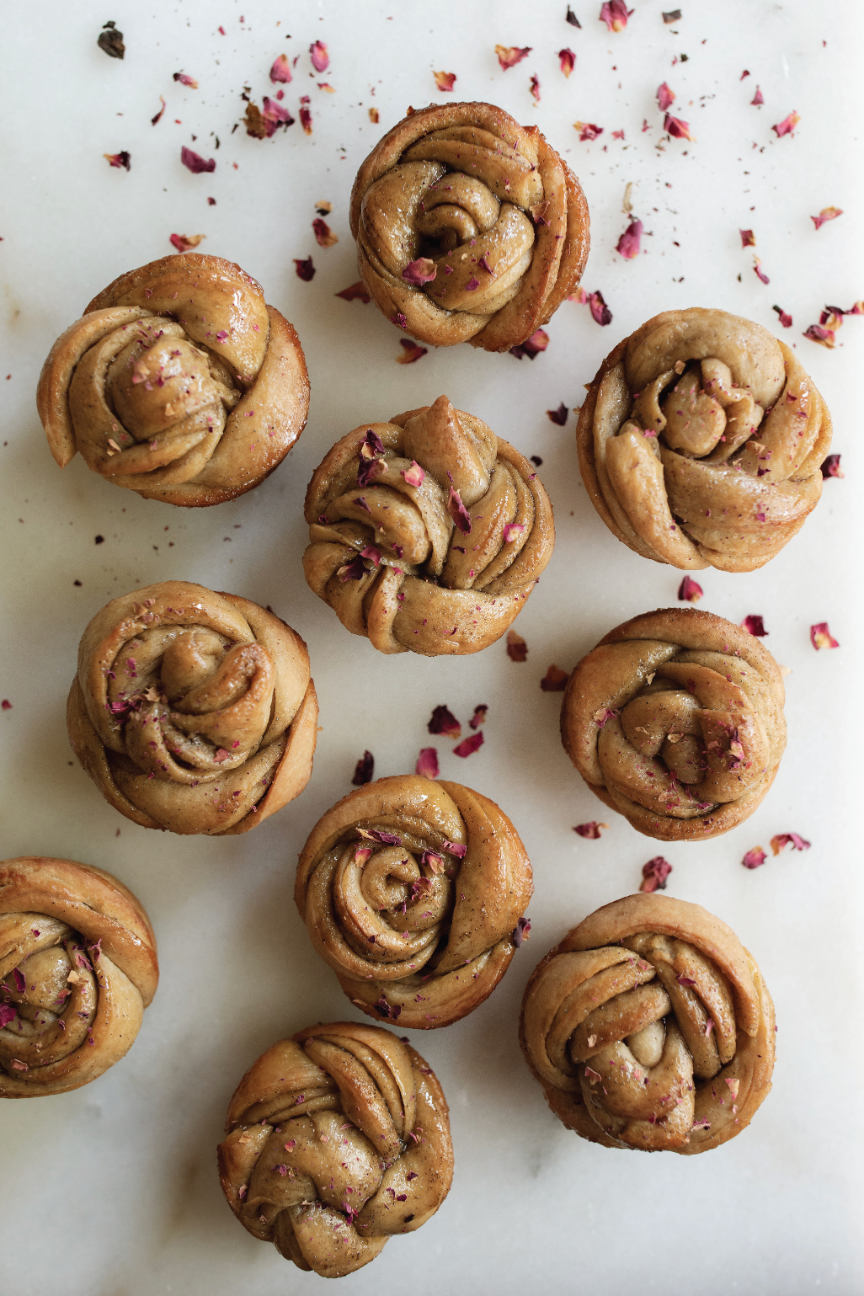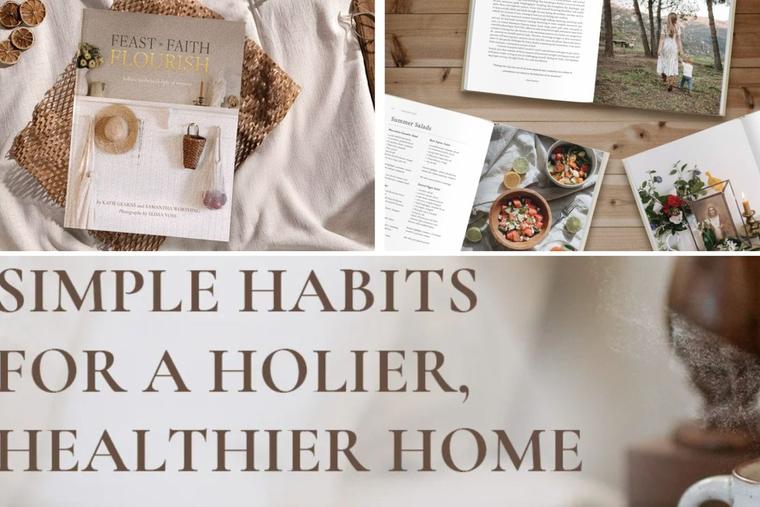Want to lead a deeper liturgical life at home?
Feast Faith Flourish: Holistic Wellness in Light of Eternity (Sophia Institute Press) can help.
Compiled by the contributors to The Ember Journal, the text includes sections on modern health and “Living the Seasons,” with the authors writing colorful texts about their life in spring, summer, fall and winter; plus, numerous photos of family, outdoors scenes and some food dishes, all of which makes reading the book delightful. Also included: numerous prayers and spiritual reflections, inspiring readers to take their Catholic life of worship seriously.
Depending on the reader’s point of interest, each section has its appeal.
Topics include wonder.
“As we age, it can be easy to lose the gift of wonder so innate to a child,” the book explains, adding, “But the gift of wonder not only helps us to really see God at work, but also inspires us to have the proper awe and reverence for it all. If you’ve felt like the gift of wonder has evaded you for some time, pray for it. Pray to become like a child, to wonder at the mysteries and goodness all around you — never ceasing to give glory to God.”
The authors also write of “Tending the Garden as a Prayer” in terms of life’s rhythms. “Not many of us truly consider ourselves artists. We go about life, accomplishing tasks, wiping counters, hugging friends, kissing little cheeks. But it is a beautiful thing to ponder — the admiration of the Lord’s creation as a profound prayer, as well as the small ways we can create beauty in our homes as gifts for those around us. How can we be more intentional with this?”
“One of the things so many of us long for with the return of spring: to be back in the garden,” the text continues. “To tend, to nurture, to admire, to get our hands in the soil and create something out of a seemingly plain spot, however small or large. The separation from nature that often coincides with the bitterly cold days of late winter often causes an even deeper longing for the warm sunshine and new growth that seem so very far away. To everything there is a season, and the return of spring with its lushness, color, and light is truly a beautiful tiny glimpse into the Creator’s eternity.”
They also acknowledge why we need seasons: “We’re all living and learning. The beauty of seasons is that they happen over and over.”
They add: “And every new season is an opportunity to begin again. … No matter how busy our external circumstances have us, we can all rest in the Lord. Even on the busiest days, our hearts can hide away in Jesus’ Sacred Heart, and receive their fill from the Source.”
Ample reference is given to the saints, including the Queen of All Saints.
“As Catholic women and homemakers, we have no one better to imitate than our Blessed Mother with her examples of holy silence and intimate conversations with her Son.”
And insights into the ordinary include the example of a female doctor of the Church in reference to the “holy gardener Himself”:
“Hildegard was a beautiful model of turning weaknesses into strengths for the greater glory of the Lord. Her days were rooted in the balance of prayer and work, with an emphasis on the holiness of the ordinary. She saw all of creation as a reflection of the Creator, and to her, the human body was a garden to be tended to by the holy gardener Himself. One of Hildegard’s biographers wrote that to her, ‘the physical world too has its own liturgy.’”
For those interested in food, turn to the pages in the section on “Health in the 21st Century” and the pages that underscore how important it is for shoppers and home cooks to source their food carefully, avoiding ultra-processed foods.
The writers also recommend eating not only seasonal foods but, if possible, those grown locally.
“Eating in-season foods means our bodies are exposed to different nutrient profiles all year long,” they wrote. “Not only is this wonderful for our health, but it draws us closer to God’s creation.” Ideally, buying organically grown foods from farmers is a good choice, and, importantly, one should ask about the use of any pesticides and how the plants and animals were raised.
Heading to the kitchen to prepare an upcoming meal, the home cook can offer such foods as carrots, apples, lettuce, cucumbers and many other fruits and vegetables raw. But cooking some vegetables, such as onions or tomatoes, can turn them into “super foods.” However, for most elements of a meal, foods eaten raw can make them easy to digest and better able for the body to use the nutrients.
As the authors summarized about meal preparation, “Nutrient-dense foods will always satisfy us better and fulfill our health needs more than empty calories. A properly prepared, nutrient-dense, whole foods diet is not as complex as it seems. We just need to have eyes keen for diverse real foods that contain lots of nutrients. And when we learn to prepare meals from this base, we discover a delicious assortment that gives us energy and health.”
Here’s a recipe excerpt:
Sourdough Rose Buns
For the feast of St. Elizabeth (Nov. 17)
St. Elizabeth was known for her remarkable generosity and compassion toward the poor and would often deliver bread to the hungry. Her husband, Ludwig, supported and encouraged her endeavors.
One day as Elizabeth was carrying bread to share, she encountered her husband and his hunting party. To show his companions that she was not stealing from the castle’s treasury, Ludwig asked her to reveal what was hidden in her cloak. Elizabeth’s cloak fell open, revealing many white and red roses in place of bread. While Ludwig’s companions may have been astonished, he saw this as a sign that his wife’s actions were pleasing to God. These rose-shaped buns are a delicious reminder of “The Miracle of the Roses” and the virtue of generosity. This recipe makes about 10 buns, though I love to double it and share them!
By Marisa Fredrickson
Bun Dough Ingredients:
8 Tbsp (113 g) salted butter, melted 3/4 cup (184 g) whole milk 1 large egg 1/2 cup (100 g) sourdough starter* 2 Tbsp (24 g) sugar 3 cups (360 g) flour
*If you don’t have access to sourdough
starter, you can swap the dough for your
favorite cinnamon roll dough.
Cardamom Filling Ingredients:
5 Tbsp salted butter, softened 1/3 cup brown sugar 1 1/2 tsp ground cardamom
Cardamom Glaze Ingredients:
1/4 cup water 1/4 cup brown sugar 1/2 tsp vanilla 1/2 tsp ground cardamom 1 tsp organic rose petals, plus more for decorating (optional)
Instructions for the Dough:
1. In a small saucepan, melt the butter, then turn off the heat and add the milk. Allow it to cool slightly before proceeding. We don’t want the mixture too hot.
2. In the bowl of a stand mixer fitted with a paddle attachment, combine the egg, sourdough starter, and sugar. While mixing on low, slowly pour in the milk and butter. Add in the flour and continue mixing until a sticky dough forms. Scrape the sides of the bowl, cover with a damp towel, and let rest for 30 minutes.
3. Switch to the hook attachment, and knead the dough on medium speed for 8 minutes. If the dough seems sticky, add 1 Tbsp more flour. It should be soft and smooth and pull away from the sides of the bowl. When you stretch a bit of the dough, you should be able to nearly see through it (this is called the “windowpane test”). Mix a bit longer if needed.
4. Coat your bowl with a bit of butter and place the dough back inside to rest overnight, or until doubled. This should take around 8 hours, depending on how warm your home is. If you are concerned about it becoming over-proofed, simply pop the bowl in your fridge to slow fermentation.
Bun Assembly Instructions:
1. Roll out your dough on lightly floured parchment. Aim to make a rectangle that is 13×20 inches. If you find your edges are misshapen, fold them in, then keep rolling.
2. Mix all of your filling ingredients together, then spread it across the surface of the dough with a spatula.
3. Fold the right third of the dough toward the center, then the left, like you’re folding a letter. Roll out the dough slightly again so that it is an even thickness.
4. With the long side of the dough facing you, cut 1 1/2″ strips down its length.
5. To form your roses, twist 2 strips of dough together, then roll them up into a round. Tuck each bun into a lightly oiled cupcake pan, allowing the “tail” to go in first and fill the bottom of each cup. Allow the buns to rest and rise for one hour.*
6. Preheat your oven to 350 degrees. Prepare your glaze by combining all of the ingredients in a saucepan over medium heat, stirring regularly. Bring it to a simmer, then turn it off.
7. When the buns have risen, place them in the oven and bake until they are golden brown, about 25 minutes.
8. Immediately after removing the buns from the oven, brush them with the glaze and top with more crushed rose petals. It’s important not to wait long to glaze them. Allow the buns to cool slightly before removing them from the pan, but not so long that they stick. These are best served fresh, but will keep for 2 days. *Instead of letting them rise, you can freeze the buns in the pan, and then let them thaw in the fridge before rising and baking at a later time.
 Rose Buns(Photo: Courtesy of Sophia Institute Press)
Rose Buns(Photo: Courtesy of Sophia Institute Press)

